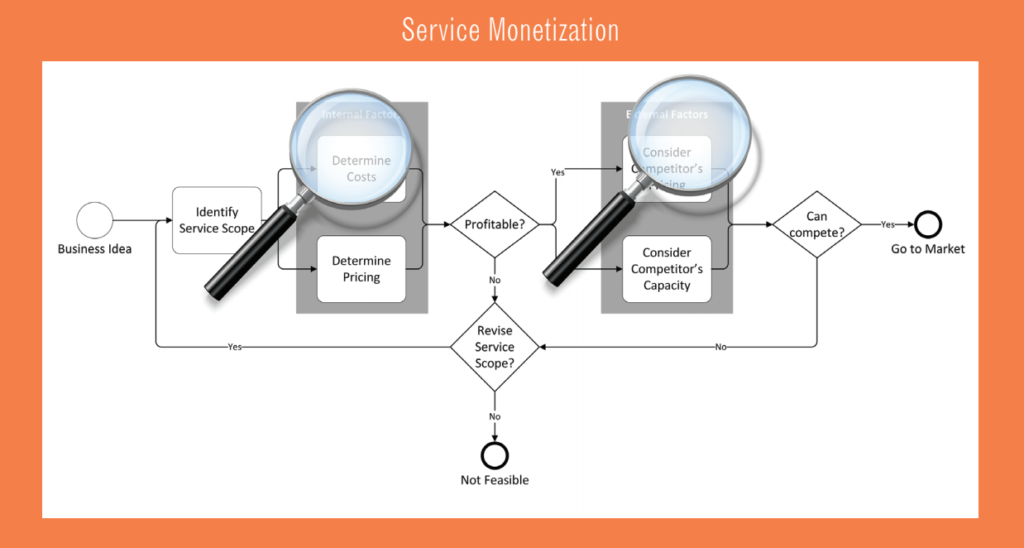HITS

M&E Journal: The Service Monetization Process
Story Highlights
By Eric Collins, Founder and President, and Neil Yu, Corporate Controller, LADB –
In the digital age, the hurdle for entering the service business of content processing has never been lower. Computer equipment and software capabilities continue to improve, and acquisition costs are now in reach of small businesses. Although industry leaders will continue to dominate the market with its breadth of capabilities and large capacities, there are opportunities out there for small businesses.
Industry leaders will naturally dictate industry standards for service expectations and pricing. All businesses strive to fulfill client deliverables as specified and on time, but it is the attention to small details that gives small businesses an edge. With minimal ability to compete in service offerings and capacity, small businesses will tend to attract clients by creating more value through attractive pricing and faster feedback that allows clients to meet or exceed budgetary expectations.
The inherently smaller structure of small businesses allows client operations or liaisons to directly interact with their counterparts within the small business service provider, as opposed to the multi-layer structure of larger companies where a client will most likely be treated as just another account that needs help.
All businesses start with a concept that is perceived to have money-making potential. One major rule to a successful brainstorming session is to not discount any idea during the first phase of the thinking process.
 In this case, the thinking process would be the monetization process presented here. There are countless services that can be offered in the content processing industry from simple video editing to the most complicated video special effects using myriad tools and software. The goal of identifying a scope is to determine the services that can be offered considering the resources that a company can allocate to the project being pursued.
In this case, the thinking process would be the monetization process presented here. There are countless services that can be offered in the content processing industry from simple video editing to the most complicated video special effects using myriad tools and software. The goal of identifying a scope is to determine the services that can be offered considering the resources that a company can allocate to the project being pursued.
Internal factors: Labor is the major cost of any content processing service provider (CPSP) and so is capital expenditure. A CPSP’s expenditures in equipment, hardware and software is mainly driven with the goal of automation and ensuring that employee time is optimized for returns. Although equipment purchased may be specific to the CPSP industry, the capabilities and features of the machine may be suitable for other service offerings. Such incremental benefits should be investigated with consideration to the incremental costs.
External factors: In a highly competitive industry, pricing and quality dictates client retention. Being able to provide more value to a client can be rephrased as “doing more work with less money.” Understanding work capacity is crucial to determine whether a CPSP can profitably compete in terms of offering a better price. Competitors will respond to any threat of losing clients with incentives ranging from price cuts to package deals. The overall market environment should also be considered to determine the future viability of a service offering.
A well-informed business decision will result from an objective profitability and competitive analysis. The monetization process is iterative until the service offering under investigation is deemed not feasible. If a decision to proceed is made, the monetization process shifts to business planning which then proceeds to execution until the service offering goes live. If an idea is deemed unfeasible, the facts gathered for the monetization process will be knowledge gained that could be used for future decision-making endeavors.
A scenario for the service monetization process discussed would be LADB’s StreamD service offering. StreamD is a secure streaming, sharing and approval system built upon security, accountability and high availability. StreamD’s monetization process ran through a process summarized as follows.
Eric Collins, LADB’s President, saw a need for a screening service that provides more value than what was in the market two years ago. This was a business idea to be explored and the project was codenamed the Stream Donkey Project.
The typical screening service out in the market includes the core feature of allowing clients to view content online. It was determined that the following additional features can be built on top of the screening service:
– Annotate any frame of a video
– Team collaboration tools
– Leverage mobile app platforms and allow content viewing through mobile apps
– Secure all content with watermarking and DRM
– Enable offline content viewing for traveling users
– Provide accountability tools
Internal factors were identified and analyzed. Profitability was determined by estimating the dollar value of potential revenue, less all identifiable costs of the project.
– Potential revenue = Estimated client demand volume multiplied by estimated price
– Software development costs
– Core infrastructure costs with emphasis on reliability and flexibility to scale
– Maintenance costs including fixed cost consideration
– Labor costs – administrative and operations
External factors were identified and analyzed. Feedback about competitor services were obtained from clients and business partners to determine shortcomings and areas for improvement of screening systems in the market.
– Competitor pricing
– Competitor practice and availability
– Market appeal
– Potential competitor response to market entry
– Demand longevity
– Technological requirements
After considering the preceding steps, it was determined that the Stream Donkey Project was profitable, and it was a business opportunity that should be pursued. 6. A budget for the project was allotted and software development begun. The Stream Donkey Project was officially named StreamD (www.streamd.io).
Now, the current version of StreamD (v1.1 as of October 2018) offers a highly secure, searchable and monitored screening service. Security and visibility features include watermarked content, DRM capability, built-in collaboration tools, content administration console and audit logs.
Solutions like these must be built upon client needs, with internal requirements making its features easily accessible both at the user and administrator level.
—-
Click here to translate this article
Click here to download the complete .PDF version of this article
Click here to download the entire Spring/Summer 2018 M&E Journal









